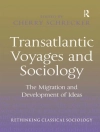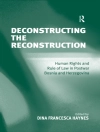The exodus of refugees from Nazi Germany in the 1930s has received far more attention from historians, social scientists, and demographers than many other migrations and persecutions in Europe. However, as a result of the overwhelming attention that has been given to the Holocaust within the historiography of Europe and the Second World War, the issues surrounding the flight of people from Nazi Germany prior to 1939 have been seen as Vorgeschichte (pre-history), implicating the Western European democracies and the United States as bystanders only in the impending tragedy. Based on a comparative analysis of national case studies, this volume deals with the challenges that the pre-1939 movement of refugees from Germany and Austria posed to the immigration controls in the countries of interwar Europe. Although Europe takes center-stage, this volume also looks beyond, to the Middle East, Asia and America. This global perspective outlines the constraints under which European policy makers (and the refugees) had to make decisions. By also considering the social implications of policies that became increasingly protectionist and nationalistic, and bringing into focus the similarities and differences between European liberal states in admitting the refugees, it offers an important contribution to the wider field of research on political and administrative practices.
Table des matières
List of Tables and Graphs
List of Abbreviations
Acknowledgements
Introduction
Frank Caestecker and Bob Moore
PART I: NATIONAL AND INTERNATIONAL ANALYSES OF POLICIES TOWARDS THE REFUGEES FROM NAZI GERMANY
Chapter 1. International Refugee Policy and Jewish Immigration under the Shadow of National Socialism
Susanne Heim
Chapter 2. The Danish Immigration Authorities and the Issue of Rassenschande
Lone Rünitz
Chapter 3. Unwilling Refuge: France and the Dilemma of Illegal Immigration, 1933–1939
Vicki Caron
Chapter 4. Dwindling Options: Seeking Asylum in Switzerland 1933–1939
Regula Ludi
Chapter 5. The 1930s: The End of the Latin American Open-door Policy
Patrick von zur Mühlen
Chapter 6. Shanghai: A Last Resort for Desperate Jews
Steve Hochstadt
Chapter 7. Palestine as a Destination for Jewish Immigrants and Refugees from Nazi Germany
Aviva Halamish
Chapter 8. American Refugee Policy in the 1930s
Bat-Ami Zucker
Chapter 9. Were Unaccompanied Child Refugees a Privileged Class of Refugees in the Liberal States of Europe?
Claudia Curio
PART II: A COMPARATIVE ANALYSIS OF IMMIGRATION POLICIES OF LIBERAL STATES IN WESTERN EUROPE AND THE FLIGHT FROM NAZI GERMANY
Frank Caestecker and Bob Moore
Chapter 9. The Legal Construction of Policy towards Aliens prior to 1933
Chapter 10. Refugees from Nazi Germany and the Development of Refugee Policies, 1933–1937
Chapter 11. The Deeping Crisis: March 1938–October 1938
Chapter 12. From Kristallnacht to War, November 1938–August 1939
Conclusion
Notes on Contributors
Bibliography
Index
A propos de l’auteur
Bob Moore is Professor of Twentieth-Century European History at the University of Sheffield. He has published extensively on the History of the Second World War, and specifically on the Holocaust, the Netherlands, and Prisoners of War. He is currently completing a book about the rescuers of Jews in Western Europe during the Nazi occupation.












